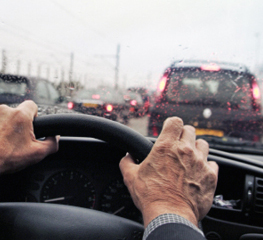 While it’s true April showers bring the promise of beautiful May flowers, the often rainy Spring weather we “enjoy” in April can also create treacherous driving conditions.
While it’s true April showers bring the promise of beautiful May flowers, the often rainy Spring weather we “enjoy” in April can also create treacherous driving conditions.
According to the Federal Highway Administration, there are more than 1.2 million weather-related vehicle crashes every year. The overwhelming majority of those crashes occur on wet pavement (73%) or when it is raining (46%).
Here are nine vehicle maintenance and driving tips to help you enjoy safe driving during the wet Spring months ahead:
VEHICLE MAINTENANCE
Make sure your tires are properly inflated. Over-inflated and under-inflated tires are unsafe, can reduce fuel economy and increase the likelihood of hydroplaning on wet roads.
Check your tire tread. Most new passenger car tires have a tread depth of 10/32″ or 11/32″. While tires with 2/32″ or less tread should definitely be replaced, keep in mind that tires can begin to lose their effectiveness before that point. Learn more, including how to test your tire tread with a penny, with this informative post from Les Schwab.
Make sure you can see and be seen. Improve visibility by replacing worn wiper blades to help ensure you can see the road and other vehicles. Check that your headlights, brake lights and turn signals are operating correctly so other drivers can see you. Wipe off your headlights occasionally; you may be surprised how much that can improve their effectiveness.
Test your brakes. Watch and listen for signs your brakes are wearing out. If your vehicle pulls to one side or if you hear grinding or squealing when you brake, have your vehicle inspected right away. It may be time for a brake repair.
ON THE ROAD
Increase the distance between you and other vehicles in rainy conditions. Stopping on wet pavement can require two to three times more distance than on dry pavement. So, be sure to leave plenty of room between yourself and the vehicle ahead of you.
Know what to do if your vehicle hydroplanes. Hydroplaning occurs when a layer of water gets between the tires and the road and the tires lose contact with the road. If your vehicle starts to hydroplane, the Oregon Department of Transportation recommends that you take your foot off the gas pedal, gently apply the brakes and steer straight ahead until your vehicle regains traction.
Turn your lights on. Drive with your low-beam headlights on, day and night, to increase your visibility to other drivers.
Be careful of standing water, which could flood your engine and do significant harm to your vehicle. If you can, drive around large puddles, running water and flooded streets. If you can’t, proceed slowly so you can stop and back out if needed.
Watch for potholes. Winter weather can be particularly tough on our roads. Keep your eyes open for potholes that, if you hit them, could damage your vehicle. But don’t swerve suddenly to avoid a pothole; by doing so, you could cause an accident of a different sort.
Resources for this article:
Oregon Department of Transportation
U.S. Department of Transportation Federal Highway Administration
AAA


